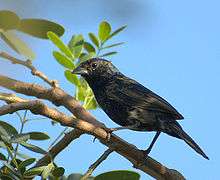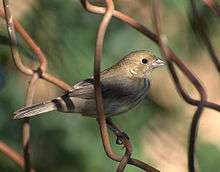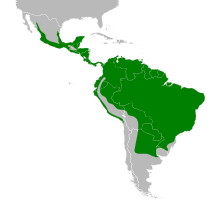Blue-black grassquit
The blue-black grassquit (Volatinia jacarina) is a small bird in the tanager family, Thraupidae. It was previously classified in the bunting and American sparrow family, Emberizidae. It breeds from southern Mexico through Central America, and South America as far as northern Chile, Argentina and Paraguay, and on Trinidad and Tobago.[2] It is the only member of the genus Volatinia.
| Blue-black grassquit | |
|---|---|
 | |
| male at Manduri, São Paulo State, Brazil | |
 | |
| female at Manduri, São Paulo State, Brazil | |
| Scientific classification | |
| Kingdom: | Animalia |
| Phylum: | Chordata |
| Class: | Aves |
| Order: | Passeriformes |
| Family: | Thraupidae |
| Genus: | Volatinia L. Reichenbach, 1850 |
| Species: | V. jacarina |
| Binomial name | |
| Volatinia jacarina (Linnaeus, 1766) | |
 | |
| Synonyms | |
|
Tanagra jacarina Linnaeus, 1766 | |
Description
Adult blue-black grassquits are 10.2 cm (4.0 in) long and weigh 9.3 g (0.33 oz). They have a slender conical black bill. The male is glossy blue-black, with a black tail and wings; the white inner underwing is visible in flight or display. Female and immature birds have brown upperparts and dark-streaked buff underparts.
Behavior
Social monogamous, extra-pair fertilizations, intraspecific parasitism, and quasi-parasitism are commonly found.[3][4] During the breeding season, males defend small territories, about 13,0 - 72,5 m2, dominant males are normally lighter.[5] The male has a jumping display, often performed for long periods, which gives rise to the local name "johnny jump-up". This is accompanied by a persistent wheezing jweeee call,[6] jumping several times in a minute.[7] The extravagant display also has a cost of call attention of predator, thus displays increase the nest predation.[8] Predation are the main cause of breeding failure,[9] and predator vocalizations can cause immune-related reaction to this species.[10] Nests are small cups of rootlets (diameter about 7.5 cm) found at herbaceous vegetation 10–50 cm high,[11] clustered at landscape,[12] and placed preferably at high complex habitat spots.[13] Nests are built by both sexes.[9][14]
References
- BirdLife International (2012). "Volatinia jacarina". IUCN Red List of Threatened Species. 2012. Retrieved 26 November 2013.CS1 maint: ref=harv (link)
- "Blue-black Grassquit (Volatinia jacarina)". www.hbw.com. Retrieved 2018-05-14.
- Carvalho, Carlos B. V.; Macedo, Regina H.; Graves, Jefferson A. (2006-08-01). "Breeding strategies of a socially monogamous neotropical passerine: extra-pair fertilizations, behavior, and morphology". The Condor. 108 (3): 579–590. doi:10.1650/0010-5422(2006)108[579:BSOASM]2.0.CO;2. ISSN 0010-5422.
- Manica, Lilian T.; Graves, Jeff A.; Podos, Jeffrey; Macedo, Regina H. (2016-12-01). "Multimodal flight display of a neotropical songbird predicts social pairing but not extrapair mating success". Behavioral Ecology and Sociobiology. 70 (12): 2039–2052. doi:10.1007/s00265-016-2208-x. ISSN 0340-5443.
- Santos, Eduardo S.A.; Maia, Rafael; Macedo, Regina H. (2009). "Condition-dependent resource value affects male–male competition in the blue–black grassquit". Behavioral Ecology. 20 (3): 553–559. doi:10.1093/beheco/arp031. ISSN 1465-7279.
- Manica, Lilian T.; Macedo, Regina H.; Graves, Jeff A.; Podos, Jeffrey (2016-09-20). "Vigor and skill in the acrobatic mating displays of a Neotropical songbird". Behavioral Ecology. 28 (1): 164–173. doi:10.1093/beheco/arw143. ISSN 1045-2249.
- Carlos Biagolini-Jr. (2018-04-25), Tiziu - Blue-black Grassquit (Volatinia jacarina), retrieved 2018-05-14
- Dias, Raphael I.; Castilho, Leonardo; Macedo, Regina H. (2010-11-01). "Experimental Evidence that Sexual Displays are Costly for Nest Survival". Ethology. 116 (11): 1011–1019. doi:10.1111/j.1439-0310.2010.01817.x. ISSN 1439-0310.
- Carvalho, C. B. V.; Macedo, R. H. F.; Graves, J. A. (May 2007). "Reproduction of Blue-black Grassquits in central Brazil". Brazilian Journal of Biology. 67 (2): 275–281. doi:10.1590/S1519-69842007000200012. ISSN 1519-6984.
- Caetano, João V.O.; Maia, Maya R.; Manica, Lilian T.; MacEdo, Regina H. (2014-11-01). "Immune-related effects from predation risk in Neotropical blue-black grassquits (Volatinia jacarina)". Behavioural Processes. 109: 58–63. doi:10.1016/j.beproc.2014.07.003. ISSN 0376-6357. PMID 25038547.
- Almeida, Juliana B.; Macedo, Regina H. (2001-04-01). "Lek-like mating system of the monogamous blue-black grassquit". The Auk. 118 (2): 404–411. doi:10.1642/0004-8038(2001)118[0404:LLMSOT]2.0.CO;2. ISSN 0004-8038.
- Dias, Raphael Igor; Kuhlmann, Marcelo; Lourenço, Luciane R.; Macedo, Regina H. (2009-11-01). "Territorial Clustering in the Blue-Black Grassquit: Reproductive Strategy in Response to Habitat and Food Requirements?". The Condor. 111 (4): 706–714. doi:10.1525/cond.2009.090142. ISSN 0010-5422.
- Aguilar, Thais M.; Dias, Raphael I.; Oliveira, Ailton C.; Macedo, Regina H. (2008-03-01). "Nest‐site selection by Blue‐black Grassquits in a Neotropical savanna: do choices influence nest success?". Journal of Field Ornithology. 79 (1): 24–31. doi:10.1111/j.1557-9263.2008.00142.x. ISSN 1557-9263.
- Carlos Biagolini-Jr. (2018-04-25), Tiziu - Blue-black Grassquit (Volatinia jacarina), retrieved 2018-05-14
External links
| Wikimedia Commons has media related to Volatinia jacarina. |
- BirdLife species factsheet for Volatinia jacarina
- "Blue-black grassquit media". Internet Bird Collection.
- Blue-black grassquit photo gallery at VIREO (Drexel University)
- Blue-black grassquit species account at Neotropical Birds (Cornell Lab of Ornithology)
- Interactive range map of Volatinia jacarina at IUCN Red List maps
- Audio recordings of Blue-black grassquit on Xeno-canto.
